DM to Sale: How Brands Are Closing Deals in the DMs!
Home About Us Services Social Media Consultation Branding Art Direction Social Media Strategy Community Management Content Creation Photography Videography Graphic Designs Illustration 2D Animation 3D Animation Web Design & Development Search Engine Optimization CPC Google Advertising Meta Advertising E-Mail Marketing Influencers Marketing’s Studio Models Home About Us Services Social Media Consultation Branding Art Direction Social Media Strategy Community Management Content Creation Photography Videography Graphic Designs Illustration 2D Animation 3D Animation Web Design & Development Search Engine Optimization CPC Google Advertising Meta Advertising E-Mail Marketing Influencers Marketing’s Studio Models Get A Qoute DM to Sale: How Brands Are Closing Deals in the DMs! Social media isn’t just for showing off your brand anymore; it’s a place to actually sell stuff. Businesses are moving away from old-school marketing and talking directly to customers. With DMs on Instagram, Facebook, and WhatsApp, brands are closing deals faster than ever. But how do they turn a casual chat into a sale? Let’s find out! Why DMs Are the Future of Sales People want a shopping experience that feels personal and easy. Instead of struggling with complicated websites, they can ask questions, negotiate, and buy things through DMs. Here’s why brands are using DMs: Instant Engagement: No waiting for emails; DMs let you talk to customers right away. Personalized Service: Conversations feel more personal, which builds trust. Higher Conversion Rates: A good DM strategy leads to direct sales without distractions. Seamless Checkout Experience: Many platforms have in-app payments, making buying easier. How Brands Are Successfully Closing Sales in the DMs Creating an Inviting DM Strategy Customers need a reason to start chatting. Brands use: Story CTAs: Phrases like “DM us for a special offer” get people to message. Exclusive Deals: Offers only available through DMs. Interactive Polls & Stickers: Engaging people through stories and posts. Live Q&A Sessions: Answering questions live to encourage DMs. Influencer Collaborations: Using influencers to drive people to their DMs. Automating Initial Interactions Many brands use chatbots or quick replies for common questions, like: “How much does it cost?” “Do you ship to my country?” “How do I order?” This saves time and allows for personal follow-ups later. Mastering the Art of Conversational Selling DM selling is about building relationships, not just pushing products. Here’s how: Personalized Greetings: A friendly opening message is key. Active Listening: Asking questions to understand what customers need. Soft Selling Approach: Highlighting benefits instead of just pushing sales. Offering Expert Advice: Showing you know your stuff before selling. Following Up: Checking in with potential buyers. Using Social Proof & Urgency Trust is important when selling in DMs. Brands build trust by: Sharing customer reviews and success stories. Showing DM sales wins in story highlights. Creating urgency with limited-time offers. Showing behind-the-scenes content. Using endorsements from celebrities or influencers. Sealing the Deal with Seamless Payment Options DM sales are faster with easy payment options. Businesses offer: Direct payment links. QR codes for quick payments. Buy Now, Pay Later options. In-app transactions on Instagram and Facebook Shop. Overcoming Objections in DM Sales Not everyone will buy right away. Here’s how brands handle objections: Price Concerns: Offering discounts or payment plans. Skepticism: Providing guarantees and reviews. Hesitation: Creating FOMO with limited stock. Comparison Shopping: Highlighting what makes their product unique. Common Mistakes to Avoid When Selling in DMs Ignoring messages. Being too pushy. Not following up. Using a robotic tone. Not tracking DM metrics. Questions to Consider Before Implementing DM Sales Where are my customers most active? How can I make my DMs feel natural? What tools can I use to automate responses? How will I track my DM sales? How can I improve my response time? What follow-up strategy will I use? Case Study: How a Fashion Brand Boosted Sales by 300% Through DMs A fashion brand in Dubai increased sales by 300% in three months by: Using Instagram Story CTAs. Setting up chatbot responses. Working with influencers. Offering flash sales for DM customers. Using in-app checkout. Final Thoughts: The Future of DM Sales DMs are now a powerful sales tool. By combining good strategies, automation, and a personal touch, brands are turning chats into sales. DM sales work because they’re personal and real-time. A good DM strategy includes engagement, automation, and trust. Using social proof, urgency, and easy payments helps close deals. Want to boost your brand’s DM sales? Boldmedia.ae can help you create a winning strategy. Contact us today! Come Work With Bold Media Collaborating can bring a fresh perspective, expertise in the latest marketing strategies, and efficient execution to your marketing efforts, ultimately helping your business reach its goals and succeed in the digital world. Come join us! Get Your Free Custom Proposal Your audience is on social media. You should be too. Bold Media Join the family! Email Address Subscribe You have been successfully Subscribed! Ops! Something went wrong, please try again. Business Centre, Sharjah Publishing City, Sharjah, United Arab Emirates Work@boldmedia.ae +971 504039664 Home About Us Services Careers Studio Work Home About Us Services Careers Studio Work Linkedin Whatsapp Facebook Instagram Copyright © 2024 boldmedia.ae | Powered by BOLD FZE LLC
DM to Sale: How Brands Are Closing Deals in the DMs! Read More »









